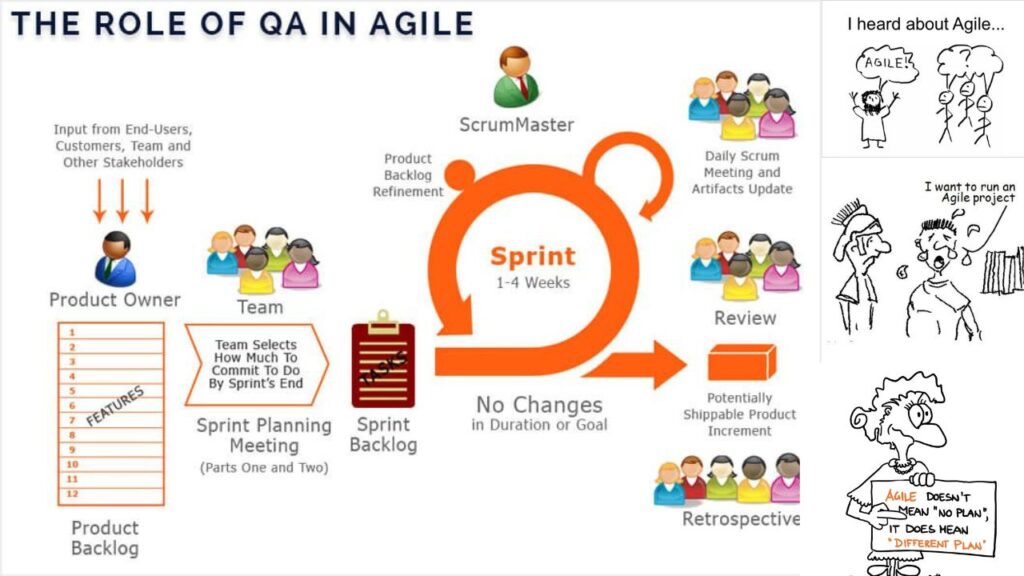Understanding Velocity in Scrum: A Guide to Calculation and Application
Table of Contents
I. Introduction
Welcome to our guide on understanding velocity in Scrum! Before we dive into the intricacies of velocity calculation and application, let’s take a moment to grasp the fundamentals. Scrum, a widely adopted Agile framework, offers a structured approach to software development, emphasizing flexibility, adaptability, and collaboration. At the heart of Scrum lies the concept of velocity, a powerful metric that helps teams gauge their productivity and plan their work effectively.
A. Brief Overview of Scrum Methodology
Scrum is an Agile methodology that divides the software development process into short iterations called sprints. Each sprint typically lasts between one to four weeks and involves a cross-functional team working collaboratively to deliver a potentially shippable product increment. Scrum is an Agile framework that emphasizes iterative development, collaboration, and flexibility in responding to change. It divides projects into small, manageable chunks called sprints, typically lasting two to four weeks, during which cross-functional teams work collaboratively to deliver a potentially shippable product increment.
Scrum fosters an environment of openness, continuous evaluation, and adaptability, empowering teams to promptly address evolving demands and feedback from stakeholders. This framework operates on the principle of transparency, encouraging teams to openly share progress, challenges, and insights throughout the development process. Through regular inspection of their work and processes, teams can identify areas for improvement and make necessary adjustments to deliver greater value to their customers. By embracing adaptation as a core tenet, Scrum empowers teams to pivot quickly in response to shifting priorities, market dynamics, and customer preferences, ensuring the timely delivery of high-quality based on the products that meet the ever-changing needs of their users.
B. Introduction to Velocity in Scrum and Its Significance in Scrum
Velocity, in the context of Scrum, refers to the amount of work a team can complete within a sprint. It serves as a key performance indicator, providing insights into the team’s capacity and productivity over time. By tracking velocity, teams can make informed decisions about sprint planning, set realistic goals, and forecast project timelines more accurately.
C. Purpose of the Blog– Velocity in Scrum
The purpose of this blog is twofold: first, to demystify the concept of velocity in Scrum and highlight its importance in Agile project management; second, to provide you with a practical, step-by-step guide to calculating velocity effectively. Whether you’re new to Scrum or looking to refine your Agile practices, this guide will equip you with the knowledge and tools needed to harness the power of velocity in your projects.
Now that we have set the stage, let’s delve deeper into the mechanics of velocity calculation and its application in Scrum.
Stay tuned for the next part of our series, where we will explore the factors influencing velocity and how to calculate it accurately. In the meantime, feel free to share your thoughts and questions in the comments section below. Happy Scrumming!
II. What is Velocity in Scrum?
Velocity in Scrum is a crucial metric that measures the amount of work a team can complete within a sprint. It serves as a yardstick for team productivity and predictability, helping teams understand their capacity and plan future work effectively.
A. Definition of Velocity in Scrum in the Context of Agile and Scrum
Velocity, within the Agile and Scrum frameworks, represents the rate at which a team delivers value to the customer in the form of completed work. It is typically measured in story points, which are abstract units used to estimate the effort required to complete a user story or task. For example, if a team completes 20 story points in a two-week sprint, their velocity for that sprint is 20.
B. Importance of Velocity as a Metric for Measuring Team Productivity and Predictability
Velocity serves as a vital indicator of team productivity and predictability in Agile projects. Here’s why it’s crucial:
- Predictability: Velocity provides teams and stakeholders with insights into how much work can be accomplished in each sprint. This predictability allows for better planning and forecasting of project timelines and releases.
- Performance Measurement: By tracking velocity over time, teams can assess their performance and identify trends. Consistent or increasing velocity indicates that the team is delivering value efficiently, while a declining velocity may signal potential issues or bottlenecks that need to be addressed.
- Resource Allocation: Velocity helps teams allocate resources effectively by understanding their capacity to take on new work. It aids in making informed decisions about sprint commitments and managing stakeholder expectations.
C. Role of Velocity in Aiding Sprint Planning and Project Forecasting
Velocity plays a pivotal role in sprint planning and project forecasting by providing teams with a baseline for estimating the amount of work they can commit to in upcoming sprints. Here’s how velocity aids in these processes:
- Sprint Planning: During sprint planning, teams use their velocity as a guideline for selecting user stories and determining the sprint backlog. By considering their historical velocity, teams can set realistic goals and ensure they don’t overcommit to work they cannot complete within the sprint timeframe.
- Project Forecasting: Velocity data accumulated over multiple sprints allows teams to forecast project timelines and delivery dates more accurately. By extrapolating past performance, teams can estimate how long it will take to complete the remaining work and communicate realistic expectations to stakeholders.
Overall, velocity in Scrum serves as a valuable tool for teams to gauge their performance, plan their work effectively, and deliver value consistently sprint after sprint.
III. Factors Affecting Velocity in Scrum
Velocity in Scrum can be influenced by various factors that impact a team’s ability to deliver work consistently from sprint to sprint. Understanding these factors is crucial for teams to effectively manage their velocity and optimize their performance.
A. Team Composition and Dynamics
The composition and dynamics of a team can significantly affect its velocity in Scrum. Factors such as team size, skill levels, and collaboration play a pivotal role in determining how efficiently work is completed. Here’s how team composition and dynamics can impact velocity:
- Team Size: Larger teams may encounter coordination challenges and communication overhead, potentially impacting their velocity. Conversely, smaller teams often benefit from increased agility and closer collaboration, leading to higher velocities.
- Skill Levels: The expertise and experience of team members can influence the speed and quality of work delivery. Teams with a diverse range of skills may be better equipped to handle a variety of tasks efficiently, resulting in higher velocities.
- Collaboration: Effective collaboration among team members fosters knowledge sharing, problem-solving, and collective ownership of work. Strong collaboration can streamline processes and eliminate bottlenecks, ultimately enhancing velocity.
Example: Suppose a team undergoes a restructuring process, resulting in the addition of new members with different skill sets. Initially, the team’s velocity may decrease as new members onboard and familiarize themselves with the project. However, over time, as the team gels and collaborates effectively, their velocity may increase as they leverage their combined expertise more efficiently.
B. Complexity of Tasks and User Stories
The complexity of tasks and user stories can significantly impact a team’s velocity in Scrum. Complex or ambiguous requirements may require more time and effort to complete, potentially slowing down the team’s progress. Here’s how task complexity affects velocity:
- Task Decomposition: Breaking down complex tasks into smaller, manageable subtasks can improve clarity and facilitate more accurate estimation. This enables teams to tackle work incrementally and maintain a steady velocity.
- Uncertainty and Risk: Tasks with high levels of uncertainty or risk may lead to delays or unexpected obstacles during implementation. Teams must factor in these uncertainties when estimating work and adjust their velocity accordingly.
Example: If a user story involves integrating a third-party API with limited documentation and potential compatibility issues, the team may need to allocate additional time for research, testing, and troubleshooting. This complexity could impact the team’s velocity for that sprint.
C. External Dependencies and Impediments
External dependencies and impediments outside the team’s control can hinder progress and affect velocity. These dependencies may include reliance on external teams, availability of resources, or delays in obtaining necessary approvals. Here’s how external dependencies and impediments impact velocity:
- Coordination Challenges: Collaborating with external teams or stakeholders introduces coordination overhead and communication challenges, potentially slowing down the team’s progress.
- Resource Constraints: Limited access to resources or tools required for task completion can lead to delays and impact velocity. Teams must identify and mitigate resource constraints to maintain their velocity.
Example: If a team is dependent on another team to provide crucial components for their project but experiences delays due to the other team’s workload, their velocity may be affected as they wait for the necessary deliverables.

D. Impact of Changes in Team Size or Skillset
Changes in team size or skillset can have a significant impact on velocity in Scrum. Onboarding new team members, losing existing members, or acquiring new skills can disrupt workflow and affect productivity. Here’s how changes in team size or skillset impact velocity:
- Onboarding Period: New team members require time to acclimate to the project, team dynamics, and processes, which may temporarily impact velocity as they ramp up their productivity.
- Loss of Expertise: Losing team members with specialized skills or domain knowledge can result in a temporary decrease in velocity until remaining team members adjust or new expertise is acquired.
Example: If a team undergoes expansion to meet increased project demands, there may be a short-term decrease in velocity as new members integrate into the team. However, as they become more familiar with the project and their roles, velocity may gradually increase to accommodate the larger team size.
IV. How to Calculate Velocity in Scrum
Calculating velocity in Scrum involves a straightforward process that allows teams to gauge their productivity accurately. Let’s break down the steps:
A. Step 1: Define the Timeframe for Measuring Velocity
Before calculating velocity, it’s essential to establish the timeframe over which it will be measured. Typically, this timeframe aligns with the duration of a sprint or iteration in the Scrum framework. For example, if your team operates on two-week sprints, the velocity calculation would be based on the work completed within each two-week sprint cycle.
B. Step 2: Identify the Units of Work to be Measured
Next, teams need to determine the units of work that will be used to measure velocity. Common units include story points, ideal hours, or tasks completed. Story points are a popular choice as they represent the relative effort required to complete a user story, making them ideal for estimating work complexity.
C. Step 3: Sum Up the Completed Units of Work Within the Defined Timeframe
During the sprint, the team tracks the completion of user stories or tasks and assigns them the appropriate units of work (e.g., story points). At the end of the sprint, the total number of completed units of work is summed up to calculate the velocity for that sprint. This sum represents the team’s capacity to deliver value within the specified timeframe.
D. Step 4: Repeat the Process for Multiple Sprints to Establish a Reliable Velocity
To establish a reliable velocity metric, teams need to repeat the calculation process over multiple sprints. By tracking velocity consistently over time, teams can identify patterns, trends, and outliers that may impact their productivity. This historical data provides valuable insights for sprint planning, capacity estimation, and project forecasting.
E. Example Calculation with Hypothetical Sprint Data
For example, let’s say a Scrum team completes the following user stories in a two-week sprint:
- User Story A: 5 story points
- User Story B: 8 story points
- User Story C: 3 story points
The total completed work for this sprint would be 5 + 8 + 3 = 16 story points. Therefore, the velocity for this sprint is 16 story points.
By following these steps and consistently tracking completed work, teams can accurately calculate and leverage velocity as a valuable metric in their Agile projects.
V. Using Velocity in Scrum for Sprint Planning
Velocity in Scrum serves as a guiding metric for sprint planning, aiding teams in making informed decisions about their capacity and commitments. Here’s how velocity data can be effectively utilized:
A. Leveraging Velocity Data to Forecast the Amount of Work a Team Can Commit to in Future Sprints
Velocity data from past sprints provides teams with valuable insights into their historical performance and capacity. By analyzing this data, teams can forecast the amount of work they can realistically commit to in upcoming sprints. For example, if a team consistently achieves a velocity of 20 story points per sprint, they can confidently plan their next sprint with a similar workload in mind.
B. Establishing a Sustainable Pace and Avoiding Overcommitment
One of the key benefits of using velocity for sprint planning is its ability to help teams establish a sustainable pace of work. By understanding their capacity based on historical velocity data, teams can avoid overcommitting to work that exceeds their capabilities. This ensures that team members can maintain a healthy work-life balance and deliver quality results consistently sprint after sprint.
C. Adjusting Sprint Scope Based on Historical Velocity Trends
Another advantage of leveraging velocity data is the ability to adjust sprint scope based on historical trends. If a team’s velocity fluctuates over time, it may indicate underlying factors affecting their productivity, such as external dependencies or changes in team composition. By monitoring velocity trends, teams can adapt their sprint scope accordingly, allocating resources more effectively and maximizing their chances of success.
In summary, velocity data plays a crucial role in sprint planning by enabling teams to forecast their capacity, establish sustainable workloads, and adapt their sprint scope based on historical trends. By incorporating velocity into their planning process, teams can improve their ability to deliver value consistently and achieve their project goals effectively.
Let’s consider a software development team that has been using Scrum for several months to deliver a new e-commerce platform. The team operates in two-week sprints and uses story points to estimate the effort required for each user story.
Example Scenario:
- Over the past three sprints, the team’s velocity has been as follows:
- Sprint 1: 20 story points
- Sprint 2: 25 story points
- Sprint 3: 22 story points
Using Velocity in Scrum Data for Sprint Planning:
A. Leveraging Velocity Data to Forecast the Amount of Work:
- Based on the average velocity of the past three sprints (22.33 story points), the team forecasts a similar workload for the upcoming sprint.
- They plan to commit to approximately 22-23 story points for the next sprint.
B. Establishing a Sustainable Pace and Avoiding Overcommitment:
- Recognizing the team’s capacity to handle around 22-23 story points per sprint, they prioritize user stories accordingly.
- They avoid overcommitment by ensuring that the sprint backlog aligns with their estimated capacity, allowing them to maintain a sustainable pace.
C. Adjusting Sprint Scope Based on Historical Velocity Trends:
- If the team notices a consistent increase or decrease in velocity over several sprints, they analyze the underlying factors influencing productivity.
- For instance, if the team experiences a decline in velocity due to unexpected technical challenges in a previous sprint, they may adjust the sprint scope to accommodate additional testing or refinement tasks in the upcoming sprint.
B. Establishing a Sustainable Pace and Avoiding Overcommitment
Velocity data helps teams establish a sustainable pace by aligning sprint goals with their capacity. By avoiding overcommitment, teams ensure they can consistently deliver high-quality work without risking burnout or compromising quality. For instance, if a team’s velocity suggests they can comfortably handle 25 story points per sprint, they should plan their workload accordingly to maintain a healthy balance between productivity and well-being.
- Align sprint goals with the team’s capacity based on velocity data.
- Avoid overcommitment to prevent burnout and maintain quality.
- Example: If a team’s velocity suggests they can comfortably handle 25 story points per sprint, they should plan their workload accordingly to maintain a healthy balance between productivity and well-being.
C. Adjusting Sprint Scope Based on Historical Velocity in Scrum Trends
Monitoring historical velocity trends allows teams to adapt sprint scope based on changes in productivity over time. If velocity trends indicate a decline in performance, teams can adjust their sprint scope to maintain a sustainable pace and ensure successful delivery. For example, if a team experiences a decrease in velocity due to unforeseen challenges, they may choose to reduce the scope of the sprint to focus on critical deliverables and maintain their commitment to delivering value within the sprint timeframe.
By leveraging velocity data for sprint planning, teams can increase predictability, optimize productivity, and deliver value consistently sprint after sprint in Scrum projects.
- Monitor historical velocity trends to identify changes in productivity.
- Adapt sprint scope to maintain a sustainable pace and ensure successful delivery.
- Example: If velocity trends indicate a decline due to unforeseen challenges, the team may reduce the sprint scope to focus on critical deliverables and maintain their commitment to delivering value within the sprint timeframe.
By leveraging velocity data for sprint planning, teams can increase predictability, optimize productivity, and deliver value consistently sprint after sprint in Scrum projects.
VI. Measuring and Tracking Velocity
Tracking velocity is essential for Scrum teams to understand their productivity and make informed decisions during sprint planning. Here’s how teams can effectively measure and track velocity:
A. Tools and Techniques for Tracking Velocity
Utilizing appropriate tools and techniques is crucial for accurately tracking velocity. Some common tools and techniques include:
- Burndown Charts: Burndown charts visually represent the progress of work throughout a sprint, showing the amount of work remaining over time. This allows teams to track their velocity and adjust their plans accordingly.
- Agile Project Management Software: Agile project management software, such as Jira or Trello, provides features for tracking velocity, sprint progress, and backlog items. These tools offer visibility into team performance and facilitate collaboration among team members.
B. Importance of Regular Updates and Transparency in Maintaining Accurate Velocity Data
Regular updates and transparency are key to maintaining accurate velocity data. Teams should ensure that velocity is updated consistently throughout the sprint and shared transparently with all stakeholders. This fosters trust and alignment within the team and ensures that everyone has a clear understanding of the team’s capacity and progress. For example, if a team encounters unexpected challenges that affect their velocity mid-sprint, transparently communicating these challenges allows stakeholders to adjust their expectations accordingly and support the team in addressing them.
By utilizing appropriate tools and techniques and prioritizing regular updates and transparency, Scrum teams can effectively measure and track velocity, enabling them to make data-driven decisions and optimize their performance sprint after sprint.
Example: Imagine a software development team using Jira to manage their Scrum projects. They update their velocity chart at the end of each sprint to reflect the actual amount of work completed. During sprint reviews, the team discusses any factors that may have influenced their velocity, such as unexpected technical challenges or changes in team composition. By maintaining regular updates and transparency, the team ensures that their velocity data remains accurate and actionable, allowing them to make informed decisions in subsequent sprints.
VII. Improving Velocity in Scrum
Improving velocity is a continuous process that requires proactive strategies and a collaborative team effort. Here are some effective approaches to enhance team velocity:
A. Strategies for Improving Team Velocity In Scrum
- Process Optimization: Identify inefficiencies in the development process and streamline workflows to improve productivity. This may involve simplifying processes, reducing unnecessary documentation, or implementing automation tools.
- Continuous Improvement Initiatives: Foster a culture of continuous improvement within the team by encouraging feedback, conducting retrospectives, and implementing iterative changes to enhance performance over time. This can involve experimenting with new techniques, tools, or methodologies to optimize workflow and increase efficiency.
B. Addressing Bottlenecks and Impediments
- Identify and address bottlenecks or impediments that hinder productivity and slow down progress. This may involve resolving technical debt, addressing communication barriers, or providing additional training or resources to team members.
- Regularly monitor and review the sprint backlog to identify potential blockers and take proactive steps to mitigate them before they impact velocity.
C. Encouraging Collaboration and Knowledge Sharing
- Foster a collaborative environment where team members feel empowered to share ideas, expertise, and best practices. Encourage cross-functional collaboration and knowledge sharing sessions to leverage the collective intelligence of the team.
- Establish clear communication channels and encourage open dialogue to facilitate the exchange of information and ideas. This can help identify opportunities for optimization and innovation that contribute to improved velocity.
Example: Suppose a Scrum team identifies that their velocity has been consistently lower than expected due to frequent interruptions during sprint execution. To address this, they implement strategies such as:
- Process Optimization: The team reviews their sprint ceremonies and identifies opportunities to streamline meetings and improve time management.
- Addressing Bottlenecks: They conduct a root cause analysis to identify the primary sources of interruptions and take proactive measures to address them. This may involve allocating dedicated focus time for development tasks or implementing communication protocols to minimize disruptions.
- Encouraging Collaboration: The team organizes knowledge sharing sessions where members can share tips, tricks, and lessons learned to enhance productivity and foster a culture of continuous improvement.
By implementing these strategies and fostering a collaborative environment, the team can effectively improve their velocity and deliver value more efficiently in future sprints.
VIII. Common Pitfalls with Velocity in Scrum
While velocity is a valuable metric in Scrum, there are common pitfalls that teams may encounter when interpreting and using velocity data.
A. Misinterpretation of Velocity Data Leading to Inaccurate Forecasts
- Misunderstanding velocity as a fixed measure of team productivity can lead to inaccurate forecasts. It’s essential to recognize that velocity may fluctuate due to various factors and should be interpreted in context.
- Teams may misinterpret velocity spikes or drops as indicative of permanent changes in productivity, leading to unrealistic expectations or overcommitment in subsequent sprints.
B. Overreliance on Velocity as the Sole Measure of Team Performance
- Relying solely on velocity to measure team performance overlooks other important aspects of productivity, such as quality, collaboration, and stakeholder satisfaction.
- Focusing solely on increasing velocity may incentivize teams to prioritize quantity over quality, leading to rushed or incomplete work.
C. Lack of Alignment Between Velocity and Business Goals
- Velocity is a measure of output but may not necessarily align with broader business goals or objectives. It’s crucial to ensure that velocity is contextualized within the larger organizational context and aligned with strategic priorities.
- A disconnect between velocity and business goals may result in teams optimizing for velocity at the expense of delivering value to the customer or achieving business outcomes.
Example: Suppose a Scrum team consistently achieves high velocity but struggles to meet customer expectations regarding product quality. In this scenario:
- The team may misinterpret their high velocity as a sign of superior performance, leading them to forecast aggressive timelines for future sprints.
- Over time, the team’s focus on increasing velocity may result in sacrificing thorough testing and code reviews, leading to an increase in defects and customer dissatisfaction.
- Despite the impressive velocity metrics, the lack of alignment between velocity and business goals ultimately impacts the team’s ability to deliver value to the customer and achieve long-term success.
By being aware of these common pitfalls and taking proactive measures to address them, teams can leverage velocity effectively while mitigating potential risks and ensuring alignment with overall project and business objectives in Scrum projects.
IX. Conclusion-Velocity In Scrum
In conclusion, understanding and effectively utilizing velocity in Scrum is essential for teams to optimize their Agile practices and deliver value consistently. Throughout this blog, we’ve explored various aspects of velocity and its significance in Scrum methodology.
A. Key Points Covered in the Blog-Velocity In Scrum
- We began by defining velocity in the context of Agile and Scrum, highlighting its role as a metric for measuring team productivity.
- We discussed the importance of velocity in aiding sprint planning, project forecasting, and establishing realistic commitments.
- Furthermore, we examined factors affecting velocity, such as team composition, task complexity, and external dependencies.
- Additionally, we provided a step-by-step guide to calculating velocity and explored its application in sprint planning.
- We also discussed common pitfalls associated with velocity, including misinterpretation of data and overreliance on velocity as the sole measure of performance.
B. Emphasis on the Importance of Understanding and Utilizing Velocity in Scrum
Understanding velocity allows teams to make informed decisions, set achievable goals, and adapt to changing circumstances effectively. It serves as a valuable tool for optimizing productivity, fostering collaboration, and delivering value consistently sprint after sprint. By embracing velocity as a guiding metric, teams can enhance their Agile practices and achieve greater success in their projects.
C. Encouragement for Readers to Implement Outlined Techniques – Velocity In Scrum
I encourage readers to implement the techniques outlined in this blog to enhance their Agile practices and maximize the benefits of velocity in Scrum. By leveraging velocity data for sprint planning, addressing bottlenecks, and fostering collaboration within their teams, readers can improve productivity, deliver value more efficiently, and ultimately achieve greater success in their Agile endeavors.
In conclusion, velocity in Scrum is not just a metric; it’s a guiding principle that empowers teams to deliver value consistently and adapt to changing requirements effectively. By understanding its significance and implementing best practices, teams can unlock the full potential of Agile methodologies and drive success in their projects.



